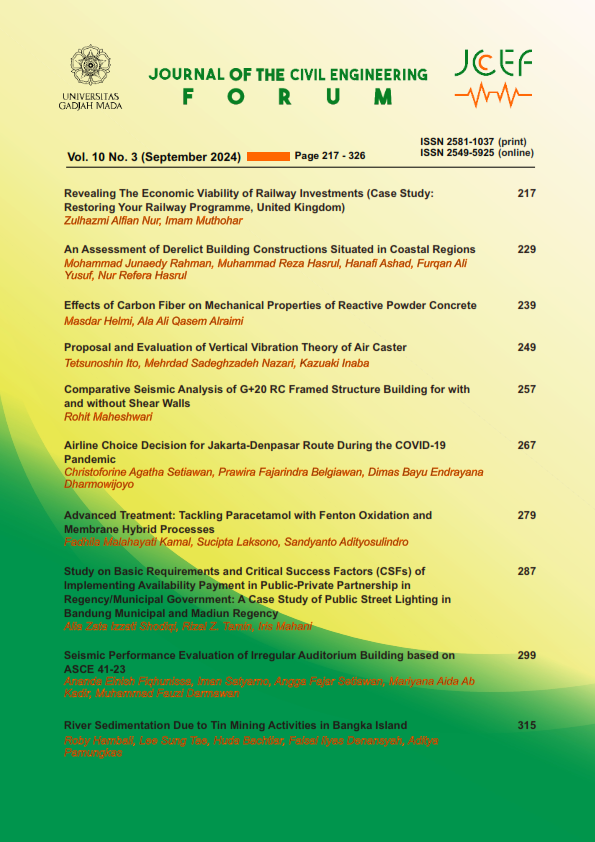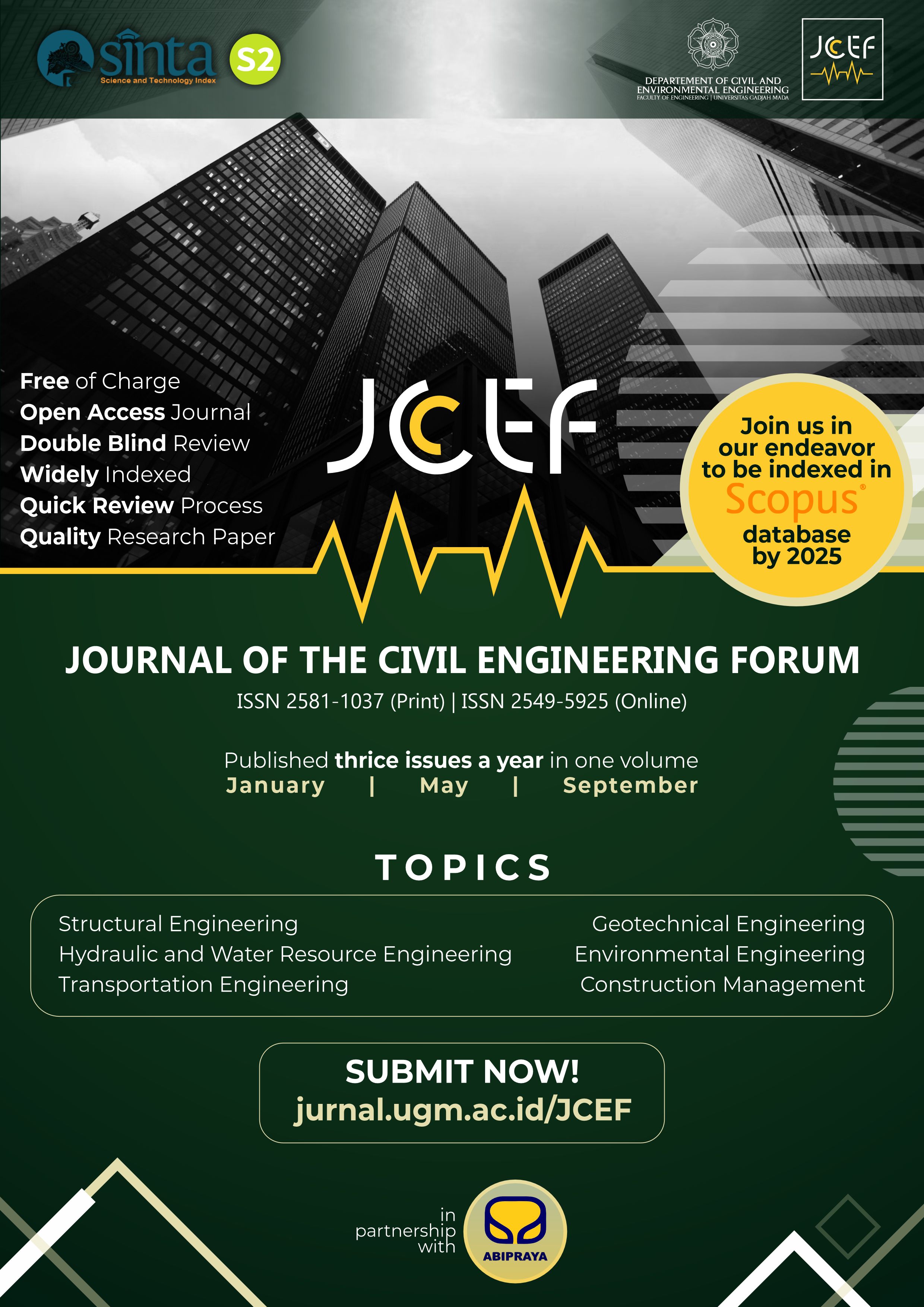An Assessment of Derelict Building Constructions Situated In Coastal Regions
Abstract
Reinforced concrete structures constructed in coastal areas in Indonesia often suffer damage before reaching their intended service life, with steel reinforcement corrosion being a major contributing factor. This study aims to investigate the use of concrete structures produced with simple methods and inadequate supervision in coastal regions. Reinforced concrete structures near the coast are susceptible to carbonation due to marine environmental factors, leading to reinforcement corrosion. The study was conducted on the Dande Dandere Market building, Tanakeke Island, Takalar Regency, South Sulawesi. The research method employed quantitative techniques, including surveys and structural testing. Visual inspections were conducted to identify the types of damage present in the building and estimate their causes. Structural testing involved both destructive and non-destructive tests. Concrete compressive strength testing was also conducted to assess the concrete sample’s compressive strength, along with carbonation testing to determine the acidity level of concrete due to the intrusion of salt compounds or carbonation formed within the concrete mass. The research findings indicate structural degradation in the market’s construction, occurring more rapidly than the intended lifespan of the building. Signs of structural degradation in the reinforced concrete construction include spalling of concrete cover on beams, supporting columns, and cantilever
slabs, as well as degraded reinforcement, with an average reduction in steel weight of 62.70% over six years, and an average weight loss of 0.103 grams per day. Therefore, efforts are needed to optimize the structural quality of the building through comprehensive repairs, starting from the foundation. However, for cost-efficient alternatives, it is recommended to use timber structural materials for new market construction. The use of timber in coastal buildings, which are vulnerable to marine influences, is more feasible as the presence of saltwater can inhibit wood decay caused by microorganisms.
References
Adam, J., Moreno, J., Bonilla, M. and Pellicer, T. (2016), ‘Classification of damage to the structures of buildings in towns in coastal areas’, Engineering Failure Analysis 70, 212–221. URL: https://doi.org/10.1016/j.engfailanal.2016.09.004
Agency, I. A. E. (2002), Guidebook on non-destructive testing of concrete structures, Vol. 17. URL: http://200.10.161.33/cirsoc/pdf/ensayos/tcs17_web.pdf
F, F. (2007), ‘Korosi pada beton bertulang dan pencegahannya’, SMARTek 5(3), 190–195. URL: http://jurnal.untad.ac.id/jurnal/index.php/SMARTEK/article/view/460
James, A., Bazarchi, E., Chiniforush, A., Panjebashi Aghdam, P., Hosseini, M., Akbarnezhad, A., Martek, I. and Ghodoosi, F. (2019), ‘Rebar corrosion detection, protection, and rehabilitation of reinforced concrete structures in coastal environments: A review’, Construction and Building Materials 224, 1026–1039. URL: https://doi.org/10.1016/j.conbuildmat.2019.07.250
Joseph, P. and Tretsiakova-McNally, S. (2010), ‘Sustainable non-metallic building materials’, Sustainability 2(2), 400–427. URL: http://doi.org/10.3390/su2020400
Kozak, R. A. and Cohen, D. H. (1999), ‘Architects and structural engineers: An examination of wood design and use in nonresidential construction’, International Journal of Language & Communication Disorders / Royal College of Speech & Language Therapists 49(4), 37–46. URL: http://doi.org/10.1086/250095
Kuzman, M. and Grošelj, P. (2012),‘Wood as a construction material: Comparison of different construction types for residential building using the analytic hierarchy process’, Wood Research 57, 591–600. URL: https://www.researchgate.net/publication/288811202
Liu, Y., Hao, H., Hao, Y. and Cui, J. (2022),‘Experimental study of dynamic bond behaviour between corroded steel reinforcement and concrete’, Construction and Building Materials 356, 129272. URL: https://doi.org/10.1016/j.conbuildmat.2022.129272
Medeiros, M., Gobbi, A., Réus, G. and Helene, P. (2013), ‘Reinforced concrete in marine environment: Effect of wetting and drying cycles, height and positioning in relation to the sea shore’, Construction and Building Materials 44, 452–457. URL: https://doi.org/10.1016/j.conbuildmat.2013.02.078
Moreno, J., Bonilla,M.,Adam, J., Borrachero,M. and Soriano, L. (2015),‘Determining corrosion levels in the reinforcement rebars of buildings in coastal areas. a case study in the mediterranean coastline’, Construction and Building Materials 100, 11–21. URL: https://doi.org/10.1016/j.conbuildmat.2015.09.059
Moreno, J., Pellicer, T., Adam, J. and Bonilla, M. (2018), ‘Exposure of rc building structures to the marine environment of the valencia coast’, Journal of Building Engineering 15, 109–121. URL: https://doi.org/10.1016/j.jobe.2017.11.016
Rifai, A. J. (2010), ‘Perkembangan struktur dan konstruksi rumah tradisional suku bajo di pesisir pantai parigi moutong’, Ruang: Jurnal Arsitektur 2(1). URL: https://www.neliti.com/publications/221034
Sadati, S., Arezoumandi, M. and Shekarchi, M. (2015), ‘Long-term performance of concrete surface coatings in soil exposure of marine environments’, Construction and Building Materials 94, 656–663. URL: https://doi.org/10.1016/j.conbuildmat.2015.07.094
Sangiorgio, V., Uva, G., Fatiguso, F. and Adam, J. (2019), ‘A new index to evaluate exposure and potential damage to rc building structures in coastal areas’, Engineering Failure Analysis 100, 439–455. URL: https://doi.org/10.1016/j.engfailanal.2019.02.052
Siregar and Atur, P. (2006), ‘Laju korosi tulangan pada mutu beton yang berbeda’,Jurnal SMARTek 4(2), 67–76.
Sudjono, A. (2005),‘Prediksi waktu layan bangunan beton terhadap kerusakan akibat korosi baja tulangan’, Civil Engineering Dimension 7(1), 6–15. URL: https://doi.org/10.9744/ced.7.1.pp.6-15.
Tian, Y., Zhang, G., Ye, H., Zeng, Q., Zhang, Z., Tian, Z., Jin, X., Jin, N., Chen, Z. and Wang, J. (2023), ‘Corrosion of steel rebar in concrete induced by chloride ions under natural environments’, Construction and Building Materials 369, 130504. URL: https://doi.org/10.1016/j.conbuildmat.2023.130504
Treu, A., Zimmer, K., Brischke, C., Larnøy, E., Gobakken, L., Aloui, F., Cragg, S., Flæte, P.-O., Humar, M., Westin, M., Borges, L. and Williams, J. (2019), ‘Durability and protection of timber structures in marine environments in europe: An overview’, BioResources 14(4), 10161–10184. URL: https://doi.org/10.15376/biores.14.4.treu
Wibowo, W., Safitri, E. and Deni, D. (2020), ‘Kajian karbonasi pada beton mutu tinggi memadat mandiri dengan variasi komposisi metakaolin’, Jurnal Riset Rekayasa Sipil 4(1), 1. URL: https://doi.org/10.20961/jrrs.v4i1.44632
Copyright (c) 2024 The Author(s)

This work is licensed under a Creative Commons Attribution-ShareAlike 4.0 International License.
Copyright is granted to authors for the purpose of providing protection for articles written to describe experiments and their results. JCEF will protect and defend the work and reputation of the author and are also willing to address any allegations of violation, plagiarism, fraud, etc. against articles written and published by JCEF. JCEF is published under the terms of the Creative Commons Attribution-ShareAlike 4.0 International License (CC BY-SA 4.0). The author holds the copyright and assigns the journal rights to the first publication (online and print) of the work simultaneously.




